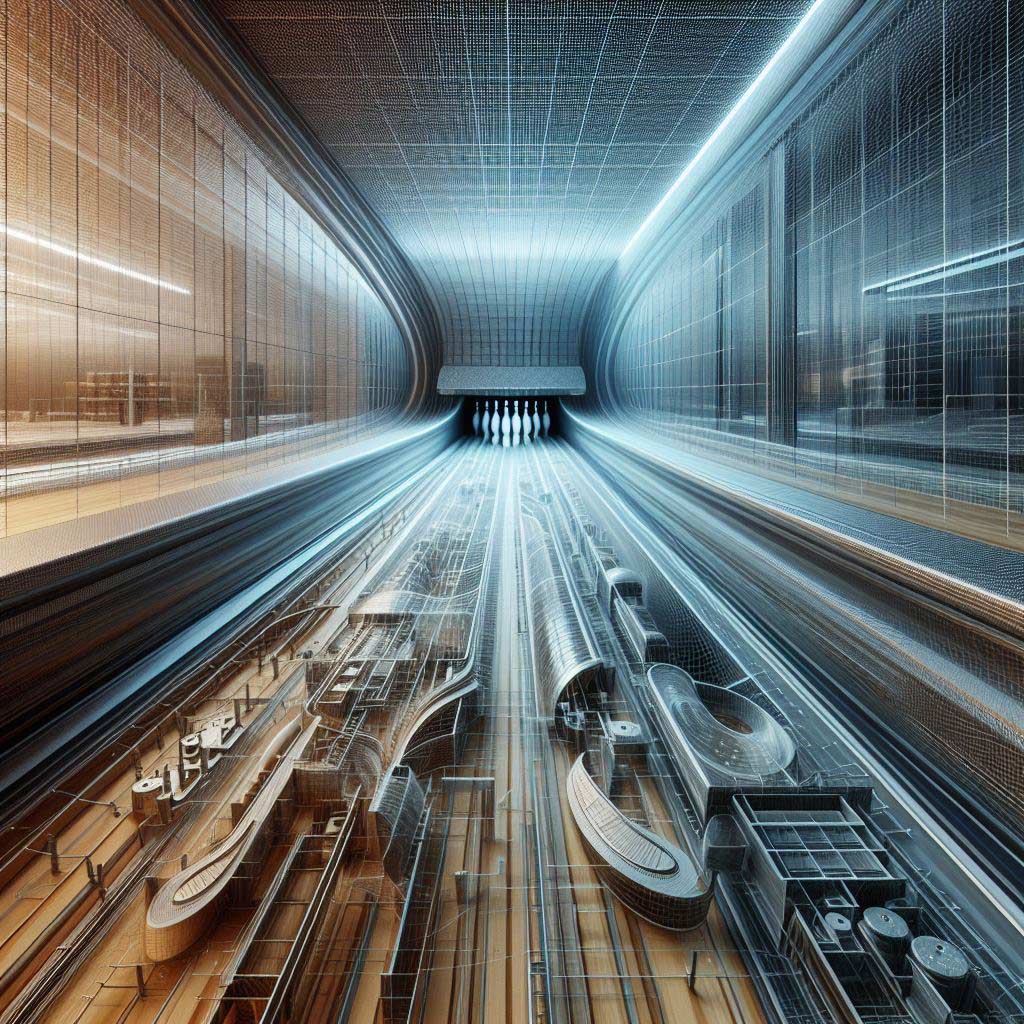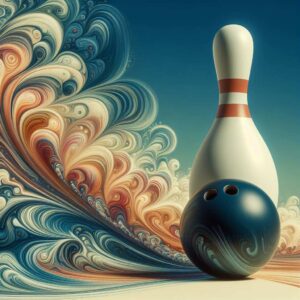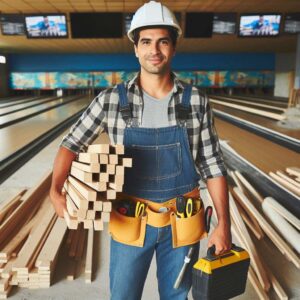Bowling is one of the most popular recreational sports played by over 70 million people in the United States alone.
The unique and specialized bowling alley construction is what lends the ideal playing surface suited for rolling balls at high speeds towards the pins.
But have you ever wondered what exactly goes into building lanes sturdy enough to handle repeated bowling action? This article will provide a comprehensive overview of the materials and methods used to create high-performance bowling alley floors.
Materials Typically Used for Constructing Bowling Lanes
The bowling surface that we play on is called the lane. Lanes have a very specialized construction to serve their purpose. They are:
Wooden Base
The foundation of most bowling alley lanes is made using hard rock maple wood sourced from maple trees. There are several reasons why hard rock maple is well suited for constructing bowling floors:
- Extremely dense and rigid surface – Its hardness provides durability to withstand repeated ball rolls.
- Ability to absorb shocks – Prevents damage from impact.
- Smooth surface with end grain – Allows easy glide of bowling balls.
- Cost-effectiveness – Relatively cheaper than synthetic alternatives.
Over 15 to 20 wooden boards are used to construct the lanes. High-quality maple sourced from reputable mills is used. Each board is interleaved and adhered using adhesives as well as nails and screws.
The length of a standard lane is 19.2 meters while being 1.06 meters wide. The final smoothness after precision milling is perfect for rolling balls consistently without interference or surface friction.
Synthetic Overlays
The wooden lanes are almost always overlaid using engineered synthetic materials to further enhance their durability and longevity. Common overlay options are:
- Laminates: Specialized multi-layered laminates protect the maple wood infrastructure while allowing easy movement of bowling balls. High-quality laminates incorporate materials like melamine and phenolic resins coated using polyurethane for abrasion resistance.
- Polymers: Various polymers and resins can also be coated on the lanes using methods like screen printing. Many modern installations use durable polymer materials layered on wood for better ball control and surface hardness. High-tech polymers reduce maintenance costs over traditional lacquered lanes.
- Gel Surface: Some contemporary lane surfaces use gelled materials with special additives. The gel coat provides good protection against direct hits from balls. The specialized gel formulation provides superb control and consistency for professional bowlers during competitive tournaments.
These overlays not only protect the maple wood over long durations but also fine-tune the ball-rolling properties as per intended gameplay. The materials enhance sliding friction behavior while giving the necessary traction for curving shots. Proprietary material blends and coatings help achieve these objectives.
Unique Construction Features of Bowling Alley Floors
The lane structure cannot simply be wooden planks laid out on any subfloor. The structural design encompasses many specialized engineering considerations:
Length and Width
Regulation lane dimensions for tournament games is 19.2 meters long and 1.06 meters wide. But recreational lanes can have shorter and narrower lengths down to 15 meters long and 1 meter width. The proportions are designed factoring in the run-up length and space for body motions needed to deliver the ball accurately.
Foundation and Subfloor System
The maple wood lane boards are fastened on top of a layered structural foundation aimed at providing maximum stability and vibration absorption. The substructure has several components:
- Concrete base for flatness
- Dense blocks for finely adjusting lane height
- Padded rubber pads for shock absorption
- Cross-bracings and joints for continuous lane support
This foundation disperses the ball impact shocks through sleeper boards instead of directly transmitting it to the main lanes thereby minimizing long-term damage.
Advanced Support Joists and Cushions
The continuous 19.2-meter wooden lanes need intermediate supports to prevent warping or cracks from repeated stress. Specialized mechanical systems are installed for added reinforcement:
- Adjustable joists underneath to counter flexing
- Compressible foam cushions spaced at regular intervals
- Last 4.5 meters is fully floating without direct subfloor contact
The floating section accommodates the slide movements of bowlers minimizing abrupt stops. The mechanical cushions absorb differential forces as balls strike specific boards thereby promoting uniformity.
Top Layer Alternatives
While maple wood is still the most popular, some modern installations employ alternative synthetic surfaces using materials like:
- Acrylic copolymers
- Reinforced melamine resin
- Fiberglass battens
- Carbon fiber
These provide high abrasion resistance for extended durations compared to traditional wood. However, the installation costs are also considerably higher. Hybrid constructions using wood base with synthetic toppers combine the pros of both materials.
Precision Sanding and Finishing
The maple planks and substructure provide just the core foundation. Transforming it into a smooth balanced playing surface involves meticulous finishing work:
- Machine sanding process eliminates unevenness
- Gap filling using specialized putty
- Filler coats for texture consistency
- Lacquer coating for protection
This brings the coefficients of friction and ball grip needed for controlled rolls. The finishing also fills any cracks or crevices that can potentially deflect balls.
Oil Patterns and Refinishing Requirements
Oiling the Lanes
Just constructing the lane is not enough. For good ball control and scoring high strikes bowling alley lanes need oil. Known as the lane conditioner, the oil is applied using precision programmable machines. But why is oiling important?
- Allows steady roll without sticking or hooking early
- Absorbs ball impacts protecting the wood
- Keeps surface clean and smooth
- Oil patterns enable various gameplay strategy
Different oil distribution patterns can significantly change ball path and hook behavior. So bowling alleys regularly apply fresh coats of approved mineral oils based on tournament requirements.
Refinishing for Continued Performance
Despite their specialized construction, lanes are still prone to wearing damage over repeated usage. Hundreds of balls continuously hitting boards at high speeds take its toll.
Additionally wood also slowly deforms over time with fluctuating moisture. This necessitates significant refinishing work at regular frequencies:
- Comprehensive deep cleaning
- Sanding and resealing uneven textures
- Filling deeper scratches and holes
- Full recoating for a refreshed finish
Based on traffic some busy bowling alleys may require partial or complete resurfacing after 4-5 years despite routine maintenance. Significantly high costs are often incurred but are imperative for delivering good bowling alley floor performance consistently.
Environmental Factors Impacting Bowling Alley Floors
Maintaining appropriate temperature and humidity levels in the bowling alley is also critical to minimize the effects of thermal expansion and moisture on the wooden lanes.
- Effects of swelling/shrinkage cycles showing as distorted surfaces
- Extreme low humidity risks cracked boards
- Excessive warmth makes woodToo pliable over time with sagging
To counter seasonal effects and maintain optimum 12-15% humidity the structures are equipped with dedicated heating/cooling systems with de/humidification facilities. Keeping temperature stable around 72°F reduces the chances of condensation accumulation even during non-operational hours.
Bowling Alley Floor Reinvestment Cycles
With daily usage bowling alley lane surfaces deteriorate much sooner compared to residential flooring. While routine cleaning, oiling, and minor repairs sustain short-term operations, approximately every 8-12 years significant overhauls become necessary.
Complete replacements involve exorbitant outlays running into six figures for even small 4-5 lane bowling alleys. It entails:
- Demolishing damaged boards
- Rebuilding underlying foundation
- Installation of new lane surfaces
- Precision calibration and finishing
Factor in revenue downtime during the 1-2 month revamp period, and owners strive to prolong reinvestment cycles as much as possible. There are specialized industry contractors offering rejuvenation services aimed at extending lifespan 5-7 years more at relatively affordable rates.
Their procedures involve:
- Identifying primarily damaged areas
- Focused structural reinforcement
- Deep frictionless cleaning
- Complete resanding and recoating
Balancing expenditures along with ideal bowling conditions and increased incomes takes smart planning.
Conclusion
The bowling lane surface construction utilizes hard maple wood reinforced with stabilizing subfloor foundations as well as synthetic overlays. Continuous mechanical supports over the 19.2-meter span and dedicated heating/cooling systems are imperative.
Routine oiling along with periodic resanding enables delivering smooth roll conditions for years. With exhaustive refinishing and partial replacements, high-traffic bowling alley floors enjoy typical lifespans of around 30 years.
Their specialized build focused on maximum ball play consistency and scoring performance sets them apart from conventional flooring.
While the long-term maintenance costs seem daunting, smart investments sustain earning potential making it worthwhile for owners given bowling’s sustained popularity over generations.
Frequently Asked Questions
What is floor of bowling alleys made of?
The floor of bowling alleys is typically made of hard rock maple wood as the base material. This wooden base has synthetic overlays like laminates or polymer coatings to improve durability. It is constructed over specialized subfloor foundations for strength.
How are bowling alley floors so strong?
Bowling alley floors are extremely strong because of their specialized multilayered construction. The hard maple wood base distributes force. Underneath layers of reinforced concrete pads, rubber cushions and adjustable supports absorb ball impacts preventing warps or cracks.
What kind of wood is commonly used as basketball or bowling alley flooring?
For both basketball courts and bowling alley lanes, hard maple wood is most commonly used because of its high density, smoothness, and shock-absorbing capacity. Maple can withstand repeated athletic activity without fracturing. It is also suitably rigid providing players good control.
How thick are bowling alley floors?
Typical bowling alley floors have a total thickness of around 4.5 inches (11 cm). This includes around 1.25 inches (3 cm) of maple wood boards stacked orthogonally on top of multilayered rigid foundations spanning another 3 inches (8 cm) made using concrete, foam, and wood.
What is the finish on a bowling lane?
The maple wood bowling lane surface is finished using a specialized lacquer coating formulated for hardness and abrasion resistance. It also controls the degree of friction allowing smooth ball rolls. The composition contains acrylic/urethane resins and additives.
What kind of wood is used in bowling alleys?
Hard rock maple sourced from reputable mills is the prime choice of wood used to construct bowling lanes across most alleys. Its strength and shock absorption enable creating the playing surface ideal for rolling heavy bowling balls consistently.
How do bowling balls not break?
Bowling balls do not break because the materials used to construct them are designed to handle extreme impacts. High-density polymers, and reactive resins reinforced using minerals/stone enable balls to endure collisions into hard surfaces at high speeds repeatedly.
Can you dent a bowling lane?
Yes, bowling lanes can get dented from repetitive high force ball throws over time. But the effects manifest slowly owing to the rigid construction. Precision balls striking the headpin at steep angles with higher entry velocities are more likely to gradually dent the wood surface.
Can you dent a bowling ball?
It is unlikely you can dent a bowling ball under normal legal use given their ultra-dense mineral-polymer composition. Dropping them from heights can damage reactive resin balls. But with proper maintenance and not using them beyond the recommended duration, bowling balls retain shape.





